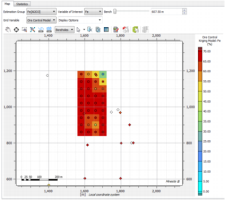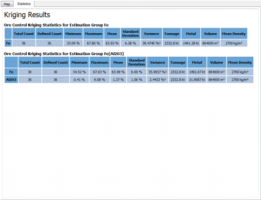Ore Control Model Computation
The fifth step of the ore control estimation workflow corresponds to the calculation of the ore control model. This is the kriging (ordinary or simple) estimation of all the variables of the selected scenario based on the blasthole information only.
Ore control estimation will take as input the variogram model and the neighborhood parameters of each estimation group defined per domain for the long-term model in Estimation per Domain. If for the estimation of a given estimation group in a particular domain, a filter or/and a capping have been set, these values will not be taken into account for the ore control estimation.
In this current version, hard boundaries are used to estimate the different domains of the partition. This means that only the blastholes that fall inside a given domain will be used to estimate the SMU of that same domain.
- Compute Ore Control Model: Click on this button to launch the computation of the ore control model.
-
Estimation Restrictions:
- If an estimation group is estimated only in one domain of the partition in the long-term model, only this domain is computed.
- If an estimation group contains accumulation variables, it is not estimated. These estimation groups are not accessible from the Estimation Group selector.
- If a variable contained in one of the estimation groups of the scenario is not imported in the blasthole data set, concerned estimation groups are not estimated.
- If no grade variable is imported in the blasthole data, the ore control model step is not available. One is able to generate an Ore Category variable and Mining Polygons. However the statistics reported are set to N/A as no ore control model is available.
Once the ore control estimation is performed, the statistics of the generated results are saved in the Statistics tab for each estimation group.
Note: The density of each block has been defined in Recoverable Resources using the Density Used For Merging parameter. Based on this density, the tonnage and the metal quantity variables are deduced.



